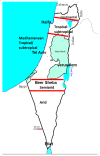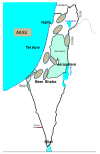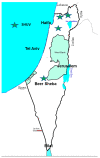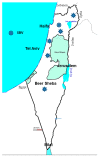Simbu Viruses' Infection of Livestock in Israel-A Transient Climatic Land
- PMID: 34834956
- PMCID: PMC8620703
- DOI: 10.3390/v13112149
Simbu Viruses' Infection of Livestock in Israel-A Transient Climatic Land
Abstract
Important lessons have been learned by the Israeli veterinary community regarding Simbu serogroup viruses infections. This serogroup of viruses might cause the births of neonatal malformation in susceptible ruminant's populations. Until 2012, only Akabane virus was connected with the births of malformed ruminants in Israel. However, serological and genomic detection tests, coupled with viral isolations, revealed that more than a single Simbu serogroup serotype could be present concurrently in the same farm or even in the same animal. From 2012 to date, Aino, Shuni, Shamunda, Satuperi, Peaton, Schmallenberg, and Sango viruses have been found in Israel either by serological or genomic investigation. Israel is located in the Eastern Mediterranean Basin, a terrestrial and climatic bridge between the three old continents. The Eastern Mediterranean shores benefit from both the tropical/subtropical and the continental climatic conditions. Therefore, the Eastern Mediterranean basin might serve as an optimal investigatory compound for several arboviral diseases, acting as a sentinel. This review summarizes updated information related to the presence of Simbu serogroup viruses in Israel.
Keywords: Culicoides; Mediterranean basin; Orthobunyavirus; Simbu viruses; emerging disease.
Conflict of interest statement
The authors declare that they have no conflict of interests.
Figures








References
-
- St George T.D., Standfast H.A. Simbu group viruses with teratogenic potential. In: Monath T.D., editor. The Arboviruses: Epidemiology and Ecology. CRC Press; Boca Raton, FL, USA: 2019. pp. 146–166.
Publication types
MeSH terms
LinkOut - more resources
Full Text Sources

